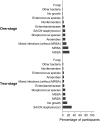One- and two-stage surgical revision of peri-prosthetic joint infection of the hip: a pooled individual participant data analysis of 44 cohort studies
- PMID: 29623671
- PMCID: PMC6153557
- DOI: 10.1007/s10654-018-0377-9
One- and two-stage surgical revision of peri-prosthetic joint infection of the hip: a pooled individual participant data analysis of 44 cohort studies
Abstract
One-stage and two-stage revision strategies are the two main options for treating established chronic peri-prosthetic joint infection (PJI) of the hip; however, there is uncertainty regarding which is the best treatment option. We aimed to compare the risk of re-infection between the two revision strategies using pooled individual participant data (IPD). Observational cohort studies with PJI of the hip treated exclusively by one- or two-stage revision and reporting re-infection outcomes were retrieved by searching MEDLINE, EMBASE, Web of Science, The Cochrane Library, and the WHO International Clinical Trials Registry Platform; as well as email contact with investigators. We analysed IPD of 1856 participants with PJI of the hip from 44 cohorts across four continents. The primary outcome was re-infection (recurrence of infection by the same organism(s) and/or re-infection with a new organism(s)). Hazard ratios (HRs) for re-infection were calculated using Cox proportional frailty hazards models. After a median follow-up of 3.7 years, 222 re-infections were recorded. Re-infection rates per 1000 person-years of follow-up were 16.8 (95% CI 13.6-20.7) and 32.3 (95% CI 27.3-38.3) for one-stage and two-stage strategies respectively. The age- and sex-adjusted HR of re-infection for two-stage revision was 1.70 (0.58-5.00) when compared with one-stage revision. The association remained consistently absent after further adjustment for potential confounders. The HRs did not vary importantly in clinically relevant subgroups. Analysis of pooled individual patient data suggest that a one-stage revision strategy may be as effective as a two-stage revision strategy in treating PJI of the hip.
Keywords: Meta-analysis; One-stage; Prosthesis related infection; Re-infection; Reoperation; Revision; Total hip replacement; Two-stage.
Conflict of interest statement
Bassam A. Masri reports institutional educational support from Zimmer and DePuy. Tim Board reports institutional financial support from DePuy Synthes. Elizabeth Darley reports personal fees from Hereus Medical outside the submitted work. Michael Whitehouse reports grants from National Institute of Health Research, during the conduct of the study; other from DePuy, grants from Stryker, other from Heraeus, outside the submitted work. Jean-Yves Jenny reports other from Aesculap, other from Exactech, other from FH Orthopedics, outside the submitted work. All other authors declare no conflict of interest.
Figures





References
-
- National Joint Registry for England and Wales: 13th Annual Report. http://www.hqip.org.uk/resources/national-joint-registry-13th-annual-rep.... Accessed 23 Dec 2017.
-
- Scottish Arthroplasty Project (2016). http://www.arthro.scot.nhs.uk/docs/2016-08-09-SAP-Report.pdf?12016. Accessed 23 Dec 2017.
Publication types
MeSH terms
Grants and funding
LinkOut - more resources
Full Text Sources
Other Literature Sources
Medical

